Zhao Changsheng/Zhao Weifeng, Sichuan University, "Nat.Biomed.Eng": Hydrogel microspheres inactivate blood coagulation factors and temporarily thin the blood during extracorporeal blood purification
During extracorporeal blood purification, anticoagulants are given to prevent thrombosis. However, due to differences between patients, it is complicated to determine the exact dose of anticoagulant, and the clearance rate of anticoagulant in these patients will vary with the disease state. Patients who receive excessive anticoagulant blood purification may have bleeding complications, such as cerebral hemorrhage, severe gastrointestinal bleeding, while patients who receive insufficient anticoagulant administration may experience coagulation-related complications, including blood Thrombosis. Therefore, the use of traditional anticoagulants in blood purification is a low-safety strategy, and key issues such as the risk of bleeding after blood purification have not been met. To cope with these key challenges, the team of Professor Changsheng Zhao and Associate Professor Zhao Weifeng of Sichuan University proposed a blood thinning strategy, which uses polymer microspheres instead of extracorporeal anticoagulant drugs to bind blood coagulation factors during cardiopulmonary bypass. When placed in a cartridge, these polymer microspheres have excellent stability and effectively bind coagulation factors VIII, IX and XI. Therefore, blood clotting is prevented in both the extracorporeal tube and the hemodialysis machine. In extracorporeal circulation, blood is introduced into a new device, and then through a hemodialysis machine or hemoperfusion device to achieve simultaneous anticoagulation, endogenous toxin removal and fluid removal. Hemophilia is caused by insufficient blood clotting factors (such as VIII, IX or XI). Therefore, we named this extracorporeal blood dilution strategy a pseudohemophilia model. Unlike the long-term deficiency of coagulation factors in hemophilia patients, the partial deficiency of coagulation factors in the pseudohemophilia model is temporary and local. After purification, pseudohemophilia blood quickly returns to its normal state after being reintroduced into the patients body, thus avoiding the use of anticoagulants. Related work was published on "Nature Biomedical Engineering" with the title "Transient blood thinning during extracorporeal blood purification via the inactivation of coagulation factors by hydrogel microspheres".
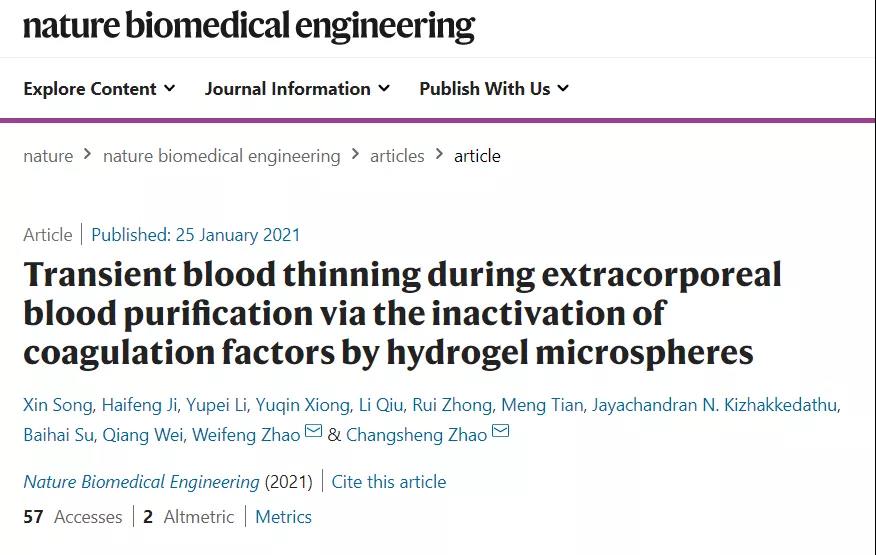
[Design, physical and chemical properties and biocompatibility of hydrogel spheres] In order to prevent accidental exposure of the hydrogel spheres to the human body, the size of the spheres is designed to be in the micron range and prepared by electrospraying. Introduce sulfonic acid groups, hydroxyl groups and carboxyl groups into the three-dimensional hydrogel network to provide blood thinning properties. In order to increase the dimensional stability of the hydrogel, a hydrophobic polymer backbone is introduced into the hydrogel network. Polyethersulfone is selected as the skeleton, and N-vinyl-2-pyrrolidone is added to enhance the hydrophilicity of the skeleton so that it can fully contact with blood. In order to explore the optimal ratio of the two polymers in the hydrogel network, various microspheres with different hydrogel networks were prepared and characterized by energy dispersion spectroscopy, elemental analysis and X-ray photoelectron spectroscopy. A series of coagulation experiments were performed to determine the optimal composition of the hydrogel network of depleted factors. The microspheres that prolonged the coagulation time from 5 minutes to more than 180 minutes at the lowest concentration were selected for further research, and they were called enhanced anticoagulation hydrogel microspheres (RAHMs). A series of experiments were conducted to evaluate the blood compatibility of RAHM. Hydrophobic polymer microspheres (HPMs) show a higher albumin adsorption level than RAHMs, indicating that they have good blood compatibility. By measuring the level of platelet adhesion and the concentration of platelet factor 4 (PF4), the effect of RAHMs on platelet activation was systematically studied. After incubating RAHM in whole blood, the concentration of PF4 produced was not significantly different from that of the control group. The hemolysis experiment was used to study the red blood cell compatibility of RAHM. The above experiments show that the effect of microspheres on blood cells is negligible, so it can be safely used for treatment. Human complement fragment 3a (C3a) and C5a were selected as representative anaphylatoxins to evaluate the effect of RAHM on the complement activation system. It was found that RAHMs did not induce the activation of the kallikrein-kinin system and inhibited the production of TAT when in contact with blood. In addition, the antibacterial adhesion properties of RAHM were also studied. It is difficult to observe obvious bacteria adhesion on the surface of RAHM, indicating that long-term storage of RAHM is possible.
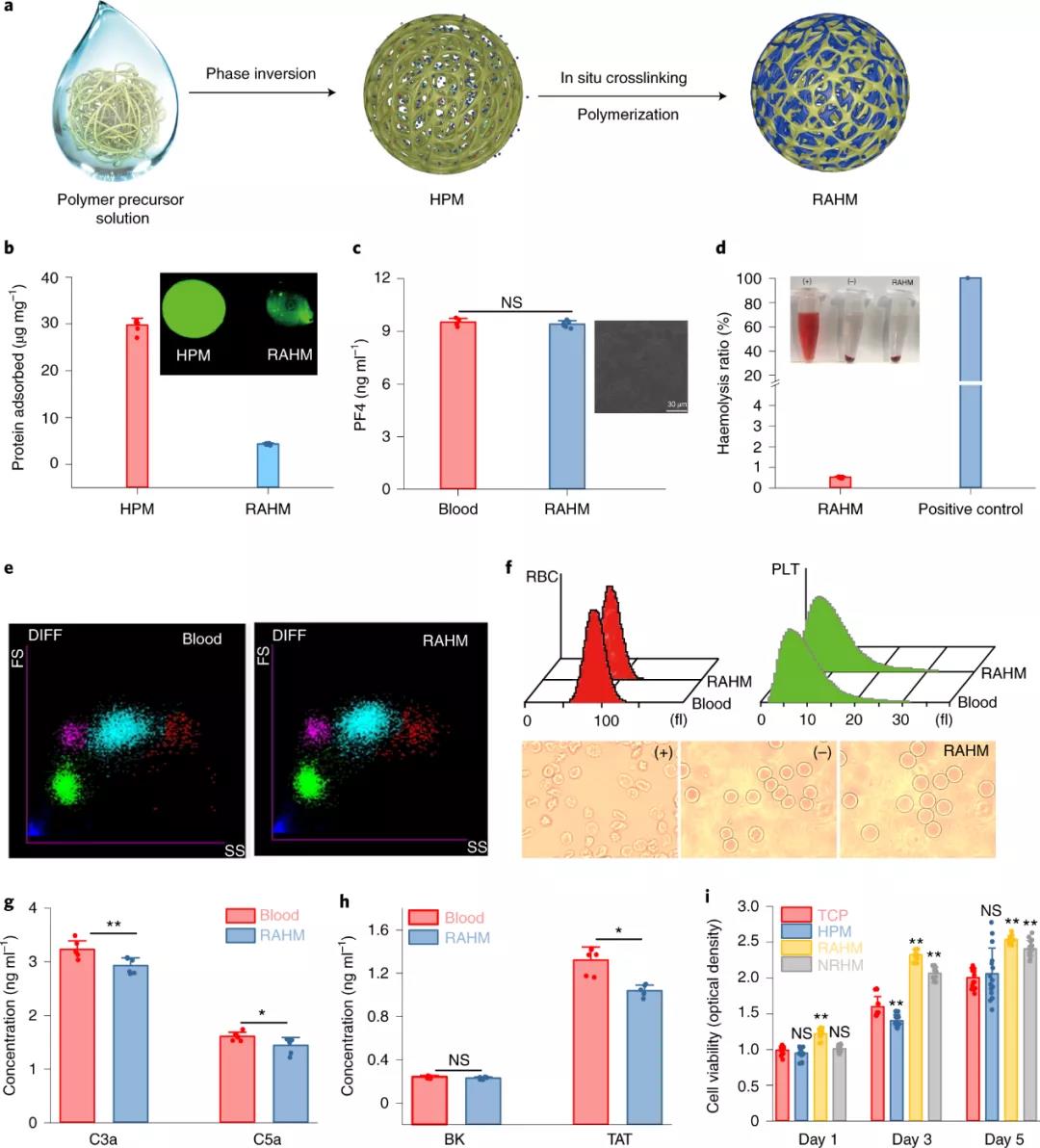
In vitro evaluation of the design and biocompatibility of spheres [Hemodilution properties of hydrogel microspheres] In order to verify the potential applicability of RAHM in blood purification, their blood dilution properties were verified in an in vitro system. After incubation with different concentrations of RAHM, the thrombin time (TT), activated partial thromboplastin time (APTT), prothrombin time (PT) and plasma fibrinogen concentration were studied. It shows that RAHMs has a strong inhibitory effect on the coagulation factors in the internal coagulation pathway, while HPMs show weak blood dilution properties. Compared with the activity of coagulation factors, RAHMs has weaker antithrombin activity. It proves that the structure of uronic acid backbone and sulfonic acid groups are very important in the design of anticoagulant polymers with heparin-like antithrombin activity. Therefore, although the sulfonated surface gives RAHM good blood dilution properties, its relatively weak heparin-like antithrombin activity may be due to the lack of uronic acid backbone. The plasma recalcification time (PRT) of RAHM at different concentrations was also studied, and serum protein electrophoresis, clotting time test and rapid thromboelastography were used to compare normal whole blood and pseudohemophilic blood. Compared with normal whole blood, pseudohemophilia blood shows longer clotting time, lower clotting factor activity and less fibrin and platelet aggregation, while the distribution of serum protein remains normal. Finally, a mass spectrometry-based proteomics study was conducted to identify the surface attachment/binding coagulation proteins on RAHM and HPM, indicating that the coagulation factor depletion ability of RAHMs is the reason for their excellent blood dilution characteristics.
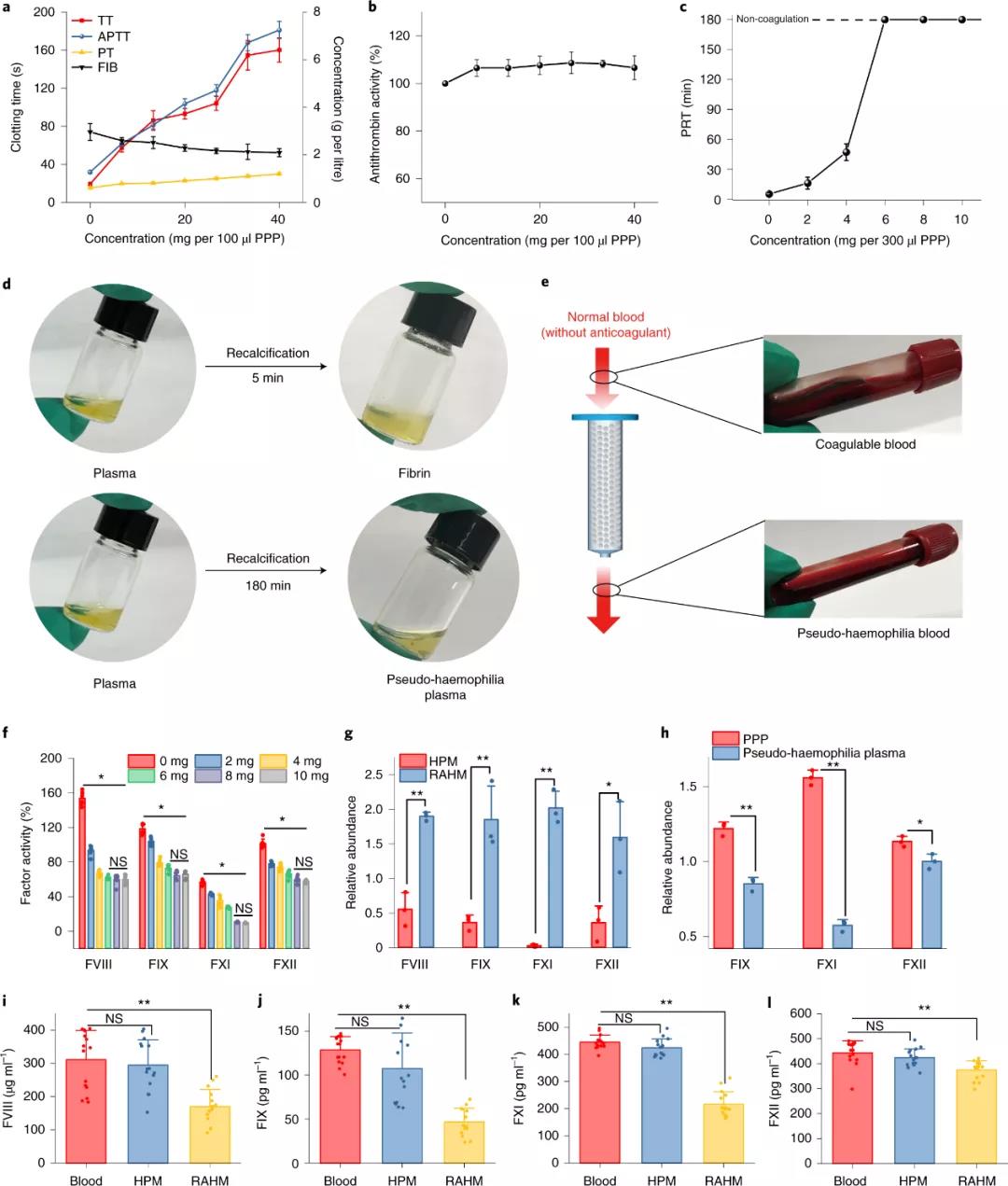
Assess the hemodilution properties of the sphere
[Efficacy and safety of pseudohemophilia model in vivo] Considering the high blood compatibility, excellent blood dilution capacity, low cytotoxicity and antibacterial adhesion properties of RAHMs, researchers do not expect to use traditional anticoagulants It is feasible to carry out in vitro anticoagulation therapy and rapid recovery of hemostatic function in vivo. Therefore, a blood thinning device was prepared by putting RAHM in a customized device, and the efficacy and safety of RAHM were studied in vivo using healthy beagle dogs.
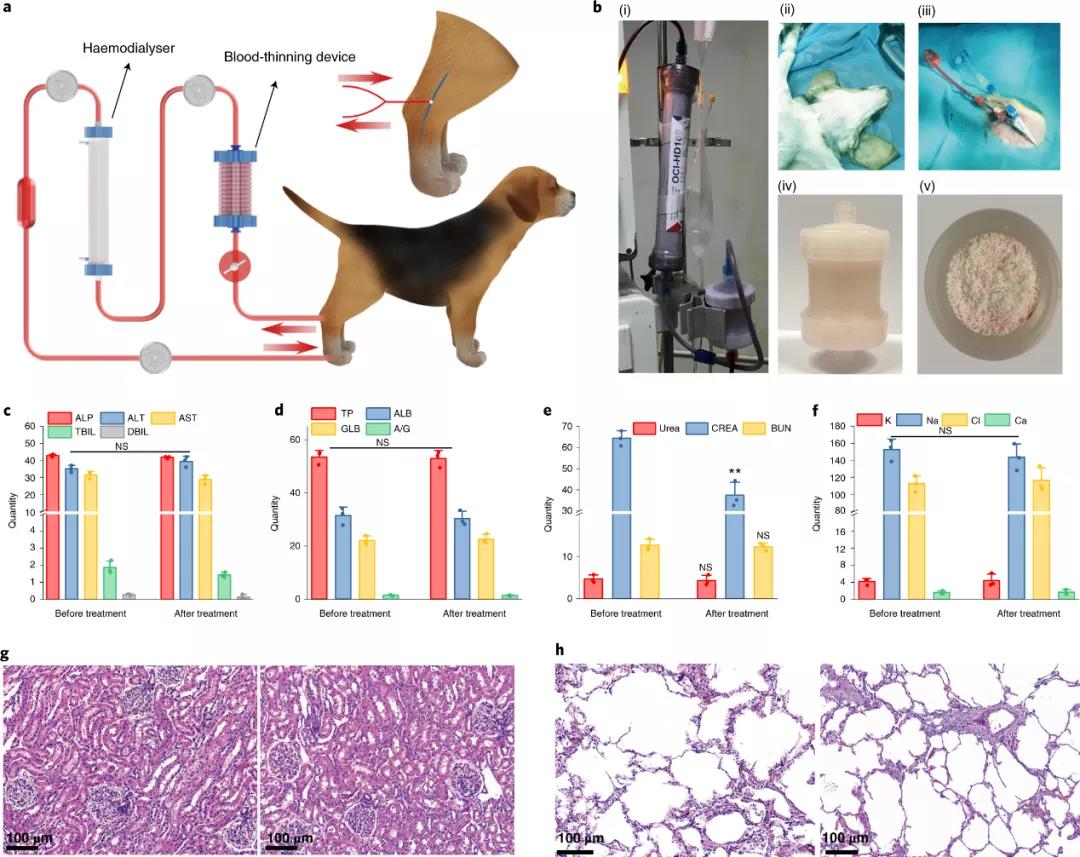
Establishment of pseudohemophilia model and its safety in vivo
[Efficacy of pseudohemophilia model in vivo] Researchers expect that by using this pseudohemophilia model, anticoagulation in vitro and hemostasis in vivo can be restored, thereby avoiding the risk of bleeding caused by traditional anticoagulants. Therefore, in animal experiments, the performance of RAHMs was systematically studied and compared with the clinically most commonly used anticoagulant heparin as a control group. During the treatment, blood samples collected at 0, 30, 60 and 120 minutes after the end of the treatment and 120 minutes after the end of the treatment undergo different clotting time tests. There was no difference in the prolongation of PT between the heparin treatment group and the RAHM treatment group. However, for APTT and TT, both groups showed significant prolongation. For the RAHM treatment group, as the treatment progresses, the extension time is gradually reduced and returns to the initial level 120 minutes after the end of the treatment, while for the heparin treatment group, the blood remains anticoagulated throughout the experiment. The pseudohemophilia model can quickly restore hemostasis. The above results indicate that the pseudohemophilia model has a remarkable ability to maintain the patency of the entire cardiopulmonary bypass. However, in clinical practice, hemodialysis requires the use of dialysate to remove toxins. Therefore, hemodialysis treatment was performed with dialysate flow to study the performance of pseudohemophilia models in clinical situations. Similar to treatment without dialysate, RAHM still shows a considerable prolongation of APTT and TT during treatment, which is sufficient to ensure successful application of hemodilution by RAHM. There is no significant difference between the APTT and TT values, which indicates that the dialysate has little effect on the hemodilution properties of RAHMs, because the coagulation factors have been consumed before passing through the dialyzer. Combined with the blood dilution characteristics of the pseudohemophilia model and the recovery of hemostatic function, the researchers believe that a safer and more ideal blood dilution strategy can be achieved in clinical hemodialysis. The researchers also studied the behavior of a pseudohemophilia model that uses a smaller dialyzer for hemodialysis, which may be more suitable for dogs.
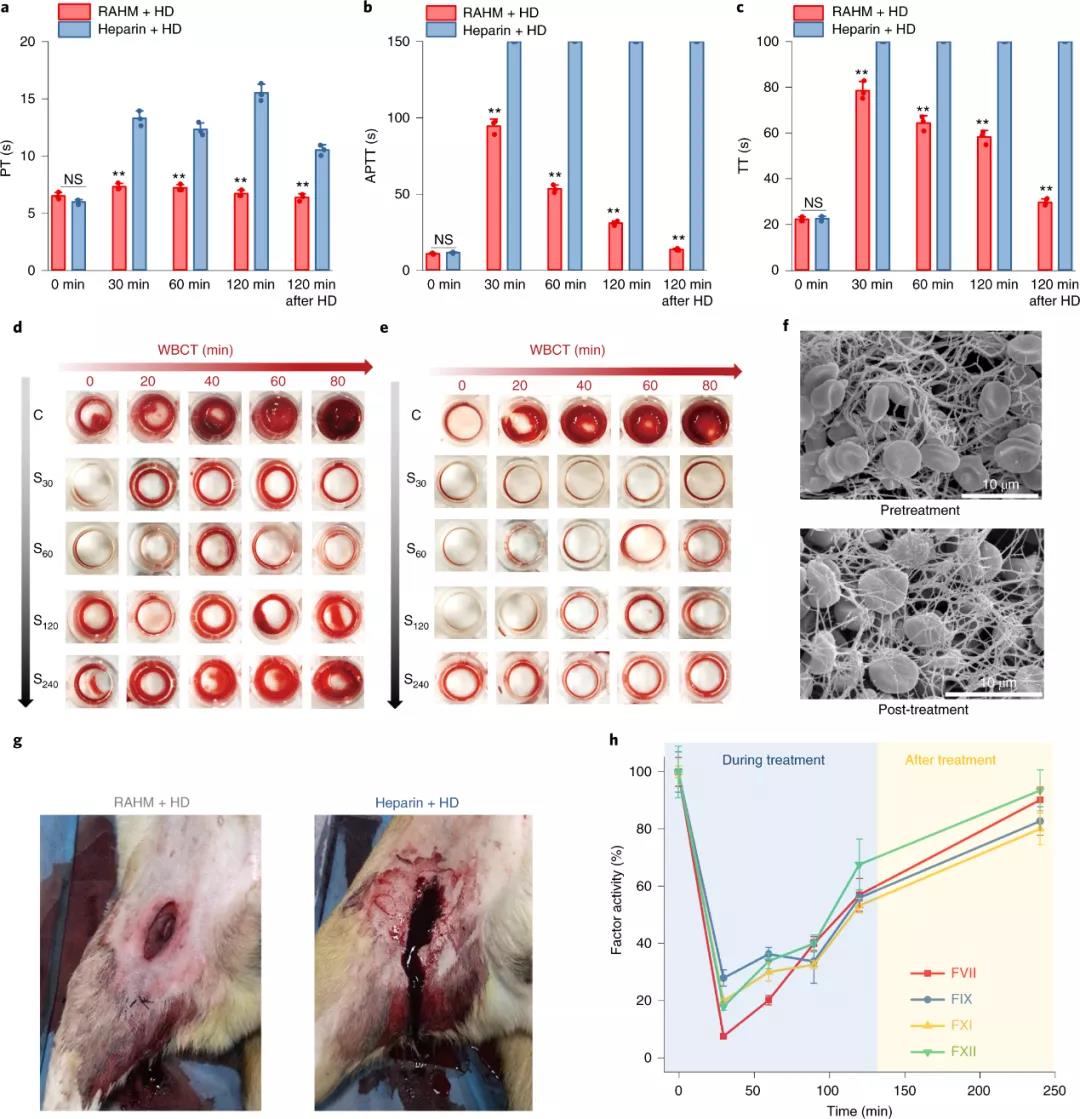
The efficacy of pseudohemophilia model in vivo
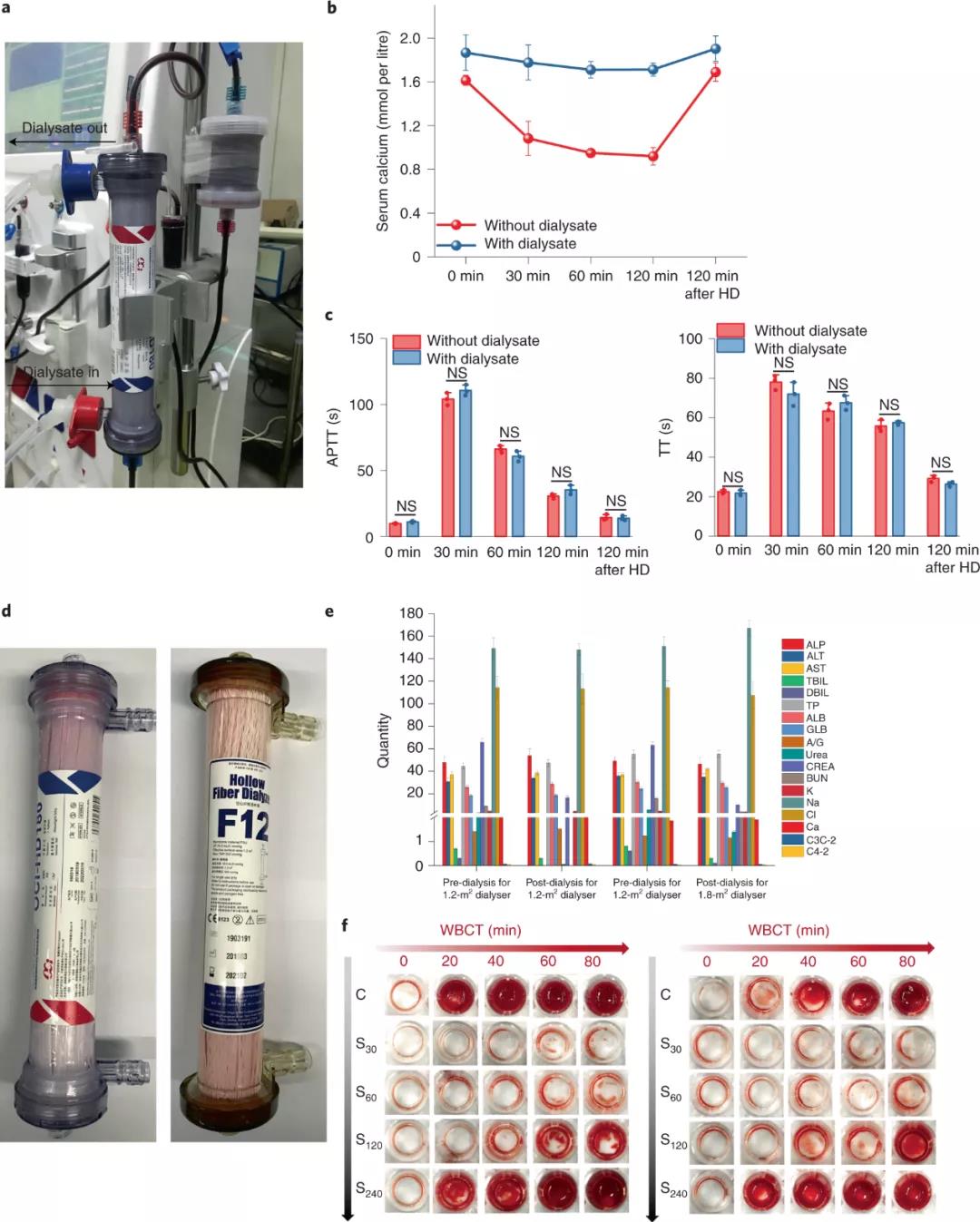
Practical application of pseudohemophilia model in hemodialysis
Summary This work shows that in vitro and in beagle dogs, hydrogel microspheres that adsorb clotting factors VIII, IX and XI provide temporary blood dilution when placed in the extracorporeal circuit before blood purification. The level of microspheres inhibiting the activity of coagulation factors is similar to the level that occurs in mild hemophilia. When it is reintroduced into the animal, the purified pseudohemophilia blood is conducive to faster recovery of hemostasis. Temporary blood thinning strategies can improve the safety of clinical blood purification procedures and avoid the risk of bleeding. And the development of the integrated RAHM equipment can also help to miniaturize the entire blood purification equipment and reduce operating steps. However, in order to be acceptable to patients, the device must be lightweight and ergonomic. These requirements can be met by replacing the heparin pump with the blood thinning device described in this work. The reduction of bleeding risk in pseudohemophilia models is more conducive to continuous treatment than traditional anticoagulation strategies, and can guide the redesign of blood purification equipment for patient care in the future.
18915694570
Previous: Nankai University Huan


